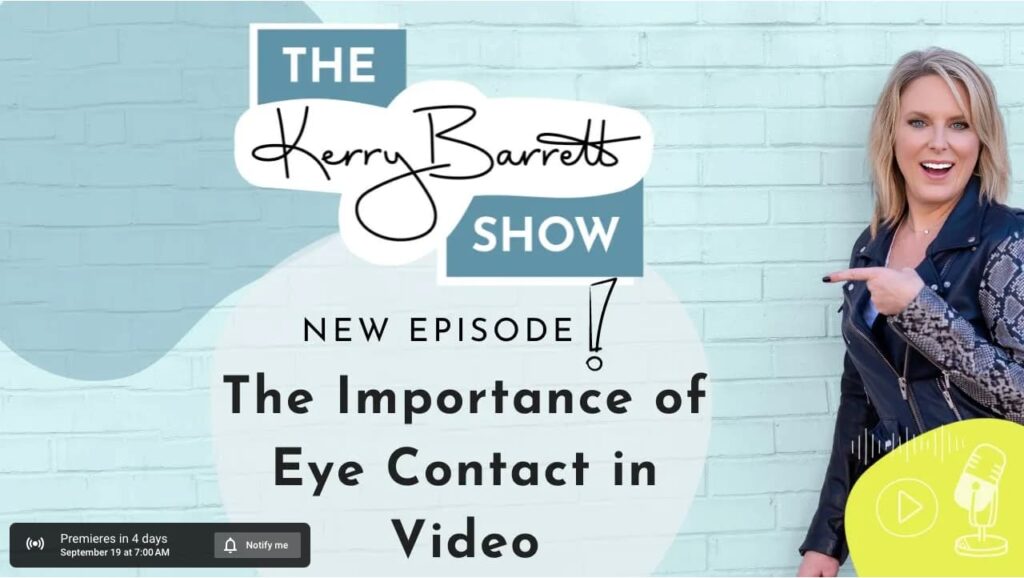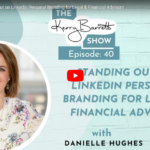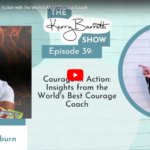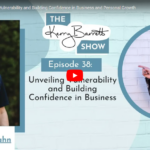
In this episode, Kerry emphasizes the power of video and on-camera communication for establishing authority and credibility. She discusses the importance of eye contact in creating a connection with viewers, particularly when presenting on camera. Drawing from her background in news broadcasting, Kerry explains that the camera lens acts as the viewer’s eye, and making eye contact with it is crucial for effective communication. She also highlights the relevance of this concept across various platforms, such as virtual keynotes, internal and external communications, landing page videos, social media, and more.
Transcript
Kerry: Hi, and thank you for joining.
Kerry: We have got a lot to talk about. As you know, through this podcast, I am a huge proponent of the power of video and on-camera communication for, you know, leveraging the lens, if you will, for digital footprint and authority and visibility, credibility, and it applies to all of the places that you might come across this sort of content.
Whether it is a virtual keynote, whether it’s internal-external communications, it is landing page videos or video sales letters or hybrid events and live streams and video podcasts and social media certainly is, you know, top of the funnel for a lot of people and the way that they bring clients in or gain awareness and visibility for their brand or business.
So eye contact is a huge component of making that connection. And I’m gonna start by sharing the reason that I know this, and the reason that I know this is because of my news background, and we all know that eye contact is important in one-to-one communication. Where it gets a little bit confusing is when you are on camera or you’re on video again, whether it’s live or recorded, you’re not actually talking to a person.
That’s directly in front of you. That camera lens, that little iris there, that’s your viewer’s eye. That is where you make your eye contact. And again, this is regardless of where you are, presenting, delivering, being seen, et cetera.
If you think about, and you may or may not watch, news, broadcast news, but if you, think to the last time you saw a show. A news show. Think about the framing of that reporter or that anchor at the desk.
We’re talking about a single-person shot, not a two-shot or multiple people, or a wide shot to show the scene, but focused on face-to-camera communication with one person on the monitor and you watching at home.
How are they framed up? Usually, there may be a couple of changes, so you could see certain things around the studio, but generally speaking, it’s a fairly tight shot. It is, you know, torso to chest up. There’s a little bit of headroom at the top and not much room on either side. That’s not how they frame things because it happens to be easier for the crew or easier for the anchor or anything like that.
They frame shots that way so that you can establish a connection with that person, that news anchor, that reporter. And the reason that’s so important is being able to look into somebody’s eyes is, whether they’re in front of you or they’re on the screen, is a big component of connection and trust, right?
We always talk about that now, like trust factor. If somebody can’t look into your eyes, even if they know there’s a reason for it, subconsciously little seeds are planted about whether that person is being genuine or whether they’re trying to cover something up. We might not even recognize that it’s happening.
But it does, and that’s why those anchors are framed that way. In fact, at the beginning of the newscast it always starts out that way, and then they can go into shots that are wider or further or whatever. But that eye contact right outta the gate, that establishes the connection, and it is done very, very intentionally. Tons of research out there that’ll show you that is in fact why they do that.
Now I wanna talk a little bit about the power of eye contact in communication and the significance of that for business owners who need to create content. And when we talk about creating content, there’s tons that you can probably think of, it’s text, it’s image posts, it’s audio, the whole nine yards.
The thing is, right now with the way AI is, you really have no idea if the words that you are reading on a piece of paper were written by the person who claims to have written them, or if it was written for that person and they are reading it.
You don’t know if a still image has been touched up and likely it has or has been altered in some way to make it look like that person is somewhere that they are not.
And the more AI is, becomes part of the fabric and the content and the context of the way that we talk about and market and sell our product, service, et cetera, the more generic it’s going to get.
The only way to make that real connection is by having somebody see your face, see your eyes, hear the words come out of your mouth as you are speaking them. Somebody that you know, and I say this over and over again, has a heart that’s beating inside of them, especially if you are using video to bring people into your funnel, into your awareness, if you will.
And so without having that component, it’s much harder to get them to know you, to like you, and to trust you. That is super important at the top of the funnel. So eye contact, I’m gonna get into a little bit of science here for you. Eye contact and there’s tons of studies that have been done about this.
One of the most recent was written about in a book called Platonic, the Art, and Science of Making and Keeping Friends, and it was written in 2022. Some of the studies and the information that the book dives into, it dives into a whole bunch of stuff. But it’s specifically focused on eye contact and what it does, what it activates in our brains.
In fact, Stetson Patton, on one of the few episodes back, talked about that book and about the power of eye contact in video.
So, eye contact activates a part of our brain called the social brain. It’s not the caveman brain. It’s not the reptilian brain, but it’s actually a set of regions that are in our brain that allow us to understand the interaction that we’re having with somebody.
It allows us to interact with them in a way that makes sense and connection. And there are signals and messages that go from eye contact directly into those portions of your brain that are very deliberate. They signal things like intention and they signal things like emotion. Intention has a lot to do with trust and how we perceive somebody, and the reason that those particular things and those regions are so important, is because it creates the ability for us to have a mutual understanding, right?
Even if you’re looking through the lens at somebody and they’re watching you on a monitor, it creates that mutual understanding. So there was another study that was published in eNeuro, which by the name of it, you can tell, is a journal about, you know, neuropsychology and neuropathy and that sort of stuff.
And there are specific areas, right? Social brain is activated, but there are specific areas within that social brain that are also especially activated. You can look at a brain scan and you can actually see these areas being highlighted when that’s taking place. And the two specific spots are the cerebellum, which helps predict sensory sort of consequences of action.
And something called the limbic mirror system, which is active when either we move or we watch somebody else moving, right? Whether it’s across the horizon or next to us or in front of us on a screen. And the reason that those two things are important is that the cerebellum helps us anticipate and understand other people’s actions.
And the limbic mirror system allows us to make that emotional connection that we’re having with somebody else and understand other people, which facilitates empathy and trust, and recognition.
So the way that the study took a look at this was by looking at a couple of pairs of adults. They used eye blinks between the two adults as a marker of how synchronized they were.
Like how much attention had been shared between the two of them. And the reason that that is important as all of this begins to come together is that, when those eye blinks are synchronized between the two of them, it shows a mutual understanding between the two of them. It shows a shared experience between the two of them, and it is fundamental for connection and it is fundamental for trust building. You’re probably beginning to put the pieces of the puzzle again about why video is so important, especially if we are not doing one-on-one work.
If we are working online, if we are working with team members or clients that live in far-flung regions at the globe or country, and we may in fact never see them in person.
Now there’s also a difference in the brain’s response to live eye contact and something called delayed eye contact. And that means there’s a real importance with making sort of a real-time connection.
So Let’s talk specifically about how that connection of our eye contact, even if we’re looking at somebody through a screen and the way that our brain lights up parlays into video and why video recorded live in whatever format it is, and being able to deliver on that video well is so important.
Okay. It helps the business owner, the brand, the executive, the whoever it is, the team member, establish connection with the viewer, with the audience. And just a little sidebar here, your audience, even if there’s millions of people watching simultaneously or asynchronously, your audience is always an audience of one.
So looking into that camera, you are looking into every single person’s eyes that are watching you. There could be a million people watching this right now and I’m looking at every single one of them individually in the eye because I’m looking at the lens of my camera, and so when they watch this, they see me looking directly at them rather than down or wherever it is that we have a tendency to look away, et cetera.
Now, I will also add an additional sidebar, you want to replicate normal patterns of conversation in camera, on camera, rather. With a little bit of nuance, so it’s okay every now and then to break gaze. In fact, if you’re watching this, I’m doing that right now as a way to demonstrate. We do that naturally in communication.
We check out the background of something, or we look up as we think about the words that we want to say, and then we come back to the screen. Breaking gaze is fine because it makes the conversation and the communication look that much more natural because it is absolutely the way that we do it, in real life.
You shouldn’t break for long. You shouldn’t break for eight seconds and never look at the camera, because then it begins to get a little bit awkward and the person, and if you’re watching this on video, you see me doing this, now the person begins to wonder what the heck that you’re looking at? So breaking gaze is fine.
What I’m talking about is, the sustained eye contact throughout the vast majority of whatever it is that you’re creating on camera or on video.
This study shows why eye contact is so important, and the fact that eye contact is so important explains why video content is so powerful. Why it makes so much more of a connection, why it is hands down the most effective and efficient way to build an audience, to build authority, to build credibility, to build growth.
You are going to find video content on social media. It’s going to go much further. And it’s not just because the algorithms prioritize it, it is because people, their brains prioritize it. They want to watch it because it feels more connected.
I wanna be clear that this applies to recorded and live video live even more powerful, right? The eye blinking in synchronization during live video is even more powerful than eye synchronization during recorded video. Both are at play. Both can be observed, but it is more immediate and more consistent during live video because of the connection.
I’m gonna underscore one more time the importance of that know, like trust factor as a business, as a brand, as an executive, as a person. It applies even if you are working in a corporation as part of a team.
That know, like trust factor is what follows you wherever you go. It’s part of your personal brand to use a buzzword that’s thrown around quite a bit.
And it’s definitely applicable to clients. It’s why sending a quick video after a sales call or if you are, going over a proposal with somebody and not all the decision makers are in the room always send a video after because it affects my close rate significantly to the positive.
Because I’ve been able to establish connections with other people that were not in the room, and I can explain it in my own words. They can see who I am. It’s so much more powerful than text. Text has its place, but anything that you’re doing with text, you can do with a camera and a video.
And now that you know the surprising amount of information that can be conveyed through the blink of an eye, let me teach you how to practice that connection. If you are getting started on video, one of the things I suggest is, right, you’re not gonna put this out there anywhere, but one of the things I suggest is opening up your smartphone and talking into the lens for 30 seconds a day.
It doesn’t matter what you’re talking about, it doesn’t matter if it’s business, it doesn’t matter if you’re in pajamas. It doesn’t matter if it’s about how much your, you know, co-worker annoys you, whatever it is that you wanna record. Nobody’s gonna see it, but you open up your phone and talk into it for 30 seconds. Just riff.
And focus on one thing. Now, in light of this particular topic, let’s talk about eye contact. A lot of times you open up your phone and you talk to the screen, and what ends up happening is you get distracted by your face and whatever is going on down below, and you end up looking at your face rather than looking into the lens, which is where your audience’s eye is.
What I would suggest is flipping your camera around so that the back, if you will, is facing you and all you can see are the lenses of your smartphone. I say lenses ’cause now they have like a bazillion but right. Look into one of these little circles on the back. It doesn’t matter which one.
And practice that way. That way you have to be focused on the lens and you get used to that feeling of not being able to use your face as a crutch or a distraction, and you can deliver like that without following exactly what you’re doing, and then go back and watch and do that every single day, 30 seconds a day for 30 days.
Focus on eye contact and see how much you improve on that element, from beginning to end. I guarantee you will see improvement. The key to getting good on camera is practicing a lot with guidance and support. That’s what I’m here for. But aside from practicing a lot, it is practicing one thing at a time, maybe two. And the reason is if you try and improve all of the things all at once, your progress in any one thing will be delayed, and it’s really easy to get super frustrated with that.
So focus on the eye contact and when you feel like you have your arms around that you can move on to the next thing. Thanks for watching and listening, and I will see you in the next episode.




